By Physician’s Weekly Blogger, Skeptical Scalpel
In the summer of 2018, Bradley Ginn Sr. died in an ambulance while being taken to a hospital in Bellingham, Washington. The fire department ambulance returned to its station so that a funeral home could pick it up. Eleven members of the department, including two office staff and an EMT not qualified to perform endotracheal intubation [ETI], practiced it on the deceased. Fifteen attempts, so-called “tube checks,” took place on the floor of the station garage.
Mr. Ginn’s daughter filed a claim for damages which the city council agreed to settle for $75,000 in December 2020. Previously, Mr. Ginn’s wife had sued the city for violating her civil rights to due process and for tortious interference with a dead body. She received a settlement of $175,000. Through a prior settlement with Mr. Ginn’s son and another daughter, the city has paid $400,000 to members of the Ginn family.
A lawyer hired by the city to investigate the incident found many troubling issues including the following:
• There was no medical reason to perform intubations on the dead body.
• No one related to Mr. Ginn was asked to consent to the intubations being done.
• Personnel did not routinely ask for family consent.
• The fire department had sanctioned tube checks for training purposes but did not have a protocol for the practice.
• Tube checks as a way for personnel to maintain their skills had been done for at least 25 years.
• Ginn had a “Do Not Resuscitate” order and the paramedics were aware of it. In fact, they usually practiced on patients with DNR orders because they knew the medical examiner would probably not review the case.
Shortly after the facts became known, one senior member of the fire department resigned and another retired.
This sort of thing is not unique to Bellingham, Washington. It has been an issue for many years. In 2001, the AMA House of Delegates supported the following: Unless reasonable efforts to obtain consent are made, “physicians must not perform procedures for training purposes on the newly deceased patient.”
A 2009 paper in the Journal of Emergency Medical Services noted the decreasing opportunities for EMS providers to learn and practice ETI. It predicted that prehospital ETI “will probably soon be a thing of the past.”
In 2018, JAMA published two large randomized trials of patients with out-of-hospital cardiac arrest. Compared to ETI, supraglottic tube placement resulted in significantly better short-term survival in one study and no significant difference in 30 day survival in the other. Two editorialists felt it might be time to reconsider the use of ETI in the field. This was followed by a review in NEJM Journal Watch expressing similar views.
Training on manikins and simulators is not enough. Practicing on recently deceased individuals without family consent is not the solution. Some have suggested that paramedics who work in areas with low volumes of ETIs spend time with anesthesia personnel in operating rooms. Unless patients are told ahead of time that paramedics will be performing intubations under supervision and consent is obtained, the OR is not the answer either. Another large obstacle to training paramedics in the OR is who is liable in the event of a complication?
References pertaining to the Ginn family settlements:
1. Firerescue.com.
2. Bellingham Herald.
3. EMS 1.com.
4. Bellingham Herald.
Skeptical Scalpel is a retired surgeon and was a surgical department chair and residency program director for many years. He is board-certified in general surgery and a surgical sub-specialty and has re-certified in both several times. For the last 9 years, he has been blogging at SkepticalScalpel.blogspot.com and tweeting as @SkepticScalpel. His blog has had more than 3,700,000 page views, and he has over 21,000 followers on Twitter.



 Janine Anthes
Janine Anthes